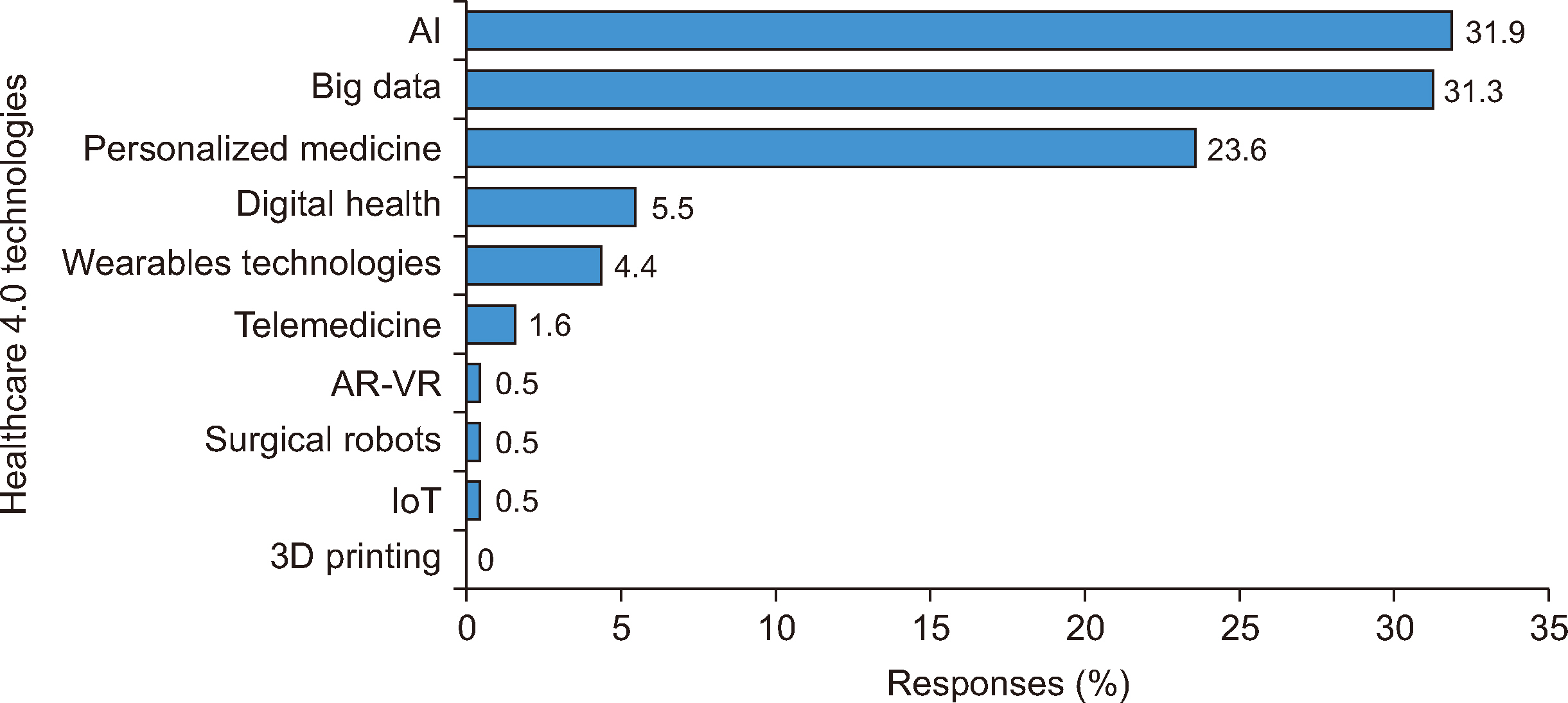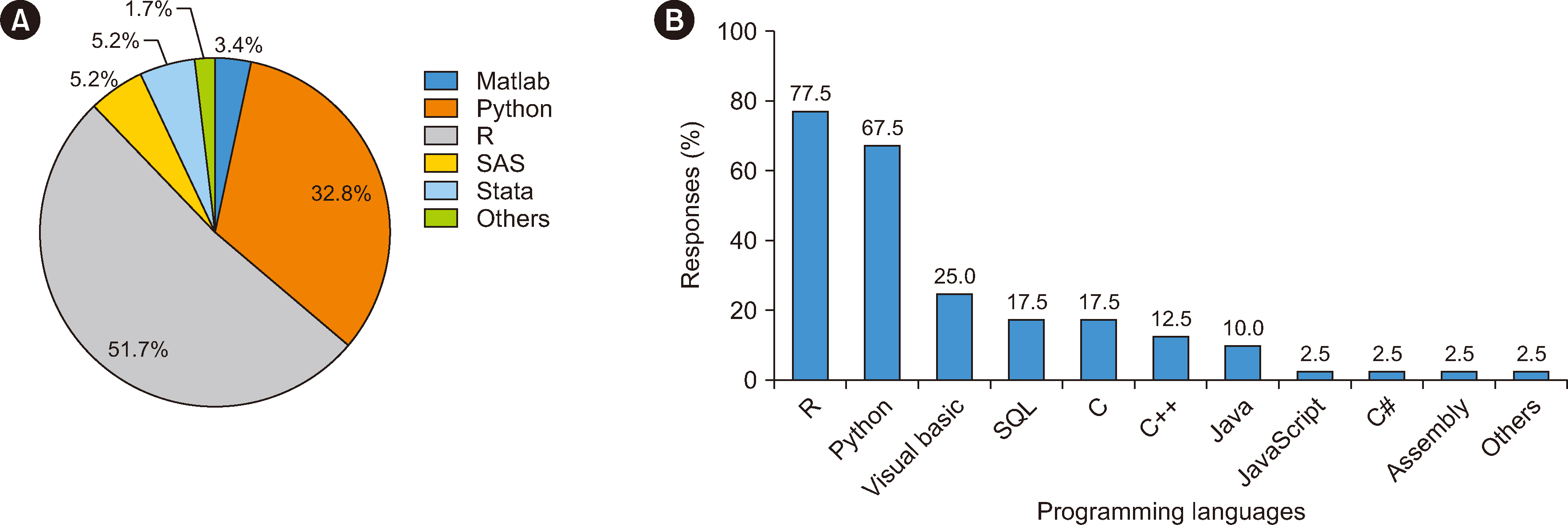Ann Lab Med.
2024 Nov;44(6):562-571. 10.3343/alm.2024.0111.
Laboratory Preparation for Digital Medicine in Healthcare 4.0: An Investigation Into the Awareness and Applications of Big Data and Artificial Intelligence
- Affiliations
-
- 1Department of Laboratory Medicine, Haeundae Paik Hospital, Inje University College of Medicine, Busan, Korea
- 2Department of Laboratory Medicine & Genetics, Soonchunhyang University Bucheon Hospital, Soonchunhyang University College of Medicine, Bucheon, Korea
- 3Departments of Laboratory Medicine, Gangneung Asan Hospital, University of Ulsan College of Medicine, Gangneung, Korea
- 4Department of Laboratory Medicine and Research Institute of Bacterial Resistance, Yonsei University College of Medicine, Seoul, Korea
- 5Department of Laboratory Medicine, College of Medicine, The Catholic University of Korea, Seoul, Korea
- 6Department of Laboratory Medicine and Genetics, Samsung Medical Center, Sungkyunkwan University School of Medicine, Seoul, Korea
- 7Department of Laboratory Medicine, Inje University College of Medicine, Busan, Korea; 8 Department of Laboratory Medicine, GC Labs, Yongin, Korea
- 8Department of Laboratory Medicine, Chungnam National University Sejong Hospital, Chungnam National University School of Medicine, Daejeon, Korea
- 9Department of Laboratory Medicine, Asan Medical Center, University of Ulsan College of Medicine, Seoul, Korea
- 10Department of Laboratory Medicine, Konkuk University Medical Center, Konkuk University School of Medicine, Seoul, Korea
- 11Department of Laboratory Medicine, Hallym University Dongtan Sacred Heart Hospital, Hallym University College of Medicine, Hwaseong, Korea
- KMID: 2560803
- DOI: http://doi.org/10.3343/alm.2024.0111
Abstract
- Background
Healthcare 4.0. refers to the integration of advanced technologies, such as artificial intelligence (AI) and big data analysis, into the healthcare sector. Recognizing the impact of Healthcare 4.0 technologies in laboratory medicine (LM), we seek to assess the overall awareness and implementation of Healthcare 4.0 among members of the Korean Society for Laboratory Medicine (KSLM).
Methods
A web-based survey was conducted using an anonymous questionnaire. The survey comprised 36 questions covering demographic information (seven questions), big data (10 questions), and AI (19 questions).
Results
In total, 182 (17.9%) of 1,017 KSLM members participated in the survey. Thirtytwo percent of respondents considered AI to be the most important technology in LM in the era of Healthcare 4.0, closely followed by 31% who favored big data. Approximately 80% of respondents were familiar with big data but had not conducted research using it, and 71% were willing to participate in future big data research conducted by the KSLM. Respondents viewed AI as the most valuable tool in molecular genetics within various divisions. More than half of the respondents were open to the notion of using AI as assistance rather than a complete replacement for their roles.
Conclusions
This survey highlighted KSLM members’ awareness of the potential applications and implications of big data and AI. We emphasize the complexity of AI integration in healthcare, citing technical and ethical challenges leading to diverse opinions on its impact on employment and training. This highlights the need for a holistic approach to adopting new technologies.
Figure
Reference
-
References
1. Gupta A, Singh A. 2023; Healthcare 4.0: recent advancements and futuristic research directions. Wirel Pers Commun. 129:933–52. DOI: 10.1007/s11277-022-10164-8. PMID: 36594000. PMCID: PMC9795952.2. Pillay TS. 2021; Artificial intelligence in pathology and laboratory medicine. J Clin Pathol. 74:407–8. DOI: 10.1136/jclinpath-2021-207682. PMID: 34031137.3. Rashidi HH, Albahra S, Robertson S, Tran NK, Hu B. 2023; Common statistical concepts in the supervised Machine Learning arena. Front Oncol. 13:1130229. DOI: 10.3389/fonc.2023.1130229. PMID: 36845729. PMCID: PMC9949554. PMID: 0c25151e79284e0aa525b3bb67851423.4. Albahra S, Gorbett T, Robertson S, D'Aleo G, Kumar SVS, Ockunzzi S, et al. 2023; Artificial intelligence and machine learning overview in pathology & laboratory medicine: a general review of data preprocessing and basic supervised concepts. Semin Diagn Pathol. 40:71–87. DOI: 10.1053/j.semdp.2023.02.002. PMID: 36870825.5. Punchoo R, Bhoora S, Pillay N. 2021; Applications of machine learning in the chemical pathology laboratory. J Clin Pathol. 74:435–42. DOI: 10.1136/jclinpath-2021-207393. PMID: 34117102.6. Rakha EA, Toss M, Shiino S, Gamble P, Jaroensri R, Mermel CH, et al. 2021; Current and future applications of artificial intelligence in pathology: a clinical perspective. J Clin Pathol. 74:409–14. DOI: 10.1136/jclinpath-2020-206908. PMID: 32763920.7. Paranjape K, Schinkel M, Hammer RD, Schouten B, Nannan Panday RS, Elbers PWG, et al. 2021; The value of artificial intelligence in laboratory medicine. Am J Clin Pathol. 155:823–31. DOI: 10.1093/ajcp/aqaa170. PMID: 33313667. PMCID: PMC8130876.8. Lee GH, Park J, Kim J, Kim Y, Choi B, Park RW, et al. 2023; Feasibility study of federated learning on the distributed research network of OMOP common data model. Healthc Inform Res. 29:168–73. DOI: 10.4258/hir.2023.29.2.168. PMID: 37190741. PMCID: PMC10209729. PMID: 54c93e5036cd4cd2a8df722038ebd115.9. Choi IY. 2023; Present and future of utilizing healthcare data. Healthc Inform Res. 29:1–3. DOI: 10.4258/hir.2023.29.1.1. PMID: 36792095. PMCID: PMC9932309. PMID: 9009cbc00ad04cff94a324d32f775219.10. Bocquet F, Campone M, Cuggia M. 2022; The challenges of implementing comprehensive clinical data warehouses in hospitals. Int J Environ Res Public Health. 19:7379. DOI: 10.3390/ijerph19127379. PMID: 35742627. PMCID: PMC9223495.11. Health Insurance Review and Assessment Service (HIRA) Bigdata Open Portal. https://opendata.hira.or.kr/home.do. Updated on Dec 2023.12. Popov VV, Kudryavtseva EV, Kumar Katiyar N, Shishkin A, Stepanov SI, Goel S. 2022; Industry 4.0 and digitalisation in healthcare. Materials (Basel). 15:2140. DOI: 10.3390/ma15062140. PMID: 35329592. PMCID: PMC8953130. PMID: ffc32244274e4995a86ac6abab6dcd79.13. Undru TR, Uday U, Lakshmi JT, Kaliappan A, Mallamgunta S, Nikhat SS, et al. 2022; Integrating artificial intelligence for clinical and laboratory diagnosis - a review. Maedica (Bucur). 17:420–6. DOI: 10.26574/maedica.2022.17.2.420. PMID: 36032592. PMCID: PMC9375890.14. Mahmudova S. 2021; Study and comparative analysis of programming languages used for big data. Rev Inf Eng Appl. 8:1–9. DOI: 10.18488/journal.79.2021.81.1.9.15. Works B. 2021. https://burtchworks.com/industry-insights/2021-survey-python-the-tool-of-choice-for-data-scientists-analytics-pros. Updated on Aug 2021.16. Cho EJ, Jeong TD, Kim S, Park HD, Yun YM, Chun S, et al. 2023; A new strategy for evaluating the quality of laboratory results for big data research: using external quality assessment survey data (2010-2020). Ann Lab Med. 43:425–33. DOI: 10.3343/alm.2023.43.5.425. PMID: 37080743. PMCID: PMC10151270.17. Yoon YA, Lee YW, Kim S, Lee K, Park HD, Chun S, et al. 2021; Standardization status of total cholesterol concentration measurement: analysis of Korean external quality assessment data. Ann Lab Med. 41:366–71. DOI: 10.3343/alm.2021.41.4.366. PMID: 33536354. PMCID: PMC7884189.18. Jeong TD, Cho EJ, Lee K, Lee W, Yun YM, Chun S, et al. 2021; Recent trends in creatinine assays in Korea: long-term accuracy-based proficiency testing survey data by the Korean association of external quality assessment service (2011-2019). Ann Lab Med. 41:372–9. DOI: 10.3343/alm.2021.41.4.372. PMID: 33536355. PMCID: PMC7884186.19. Nam Y, Lee JH, Kim SM, Jun SH, Song SH, Lee K, et al. 2022; Periodic comparability verification and within-laboratory harmonization of clinical chemistry laboratory results at a large healthcare center with multiple instruments. Ann Lab Med. 42:150–9. DOI: 10.3343/alm.2022.42.2.150. PMID: 34635608. PMCID: PMC8548239.20. Coskun A. 2024; Bias in laboratory medicine: the dark side of the moon. Ann Lab Med. 44:6–20. DOI: 10.3343/alm.2024.44.1.6. PMID: 37665281. PMCID: PMC10485854.21. Kim S. 2023; Laboratory data quality evaluation in the big data era. Ann Lab Med. 43:399–400. DOI: 10.3343/alm.2023.43.5.399. PMID: 37080739. PMCID: PMC10151286.22. Kim S, Cho EJ, Jeong TD, Park HD, Yun YM, Lee K, et al. 2023; Proposed model for evaluating real-world laboratory results for big data research. Ann Lab Med. 43:104–7. DOI: 10.3343/alm.2023.43.1.104. PMID: 36045065. PMCID: PMC9467825.23. Cascini F, Santaroni F, Lanzetti R, Failla G, Gentili A, Ricciardi W. 2021; Developing a data-driven approach in order to improve the safety and quality of patient care. Front Public Health. 9:667819. DOI: 10.3389/fpubh.2021.667819. PMID: 34095071. PMCID: PMC8175645. PMID: 9449fe29b8b84e7c806950b4e3f6345e.24. Kelly BS, Judge C, Bollard SM, Clifford SM, Healy GM, Aziz A, et al. 2022; Radiology artificial intelligence: a systematic review and evaluation of methods (RAISE). Eur Radiol. 32:7998–8007. DOI: 10.1007/s00330-022-08784-6. PMID: 35420305. PMCID: PMC9668941.25. Hosny A, Parmar C, Quackenbush J, Schwartz LH, Aerts HJWL. 2018; Artificial intelligence in radiology. Nat Rev Cancer. 18:500–10. DOI: 10.1038/s41568-018-0016-5. PMID: 29777175. PMCID: PMC6268174.26. Ma C, Wang X, Wu J, Cheng X, Xia L, Xue F, et al. 2020; Real-world big-data studies in laboratory medicine: current status, application, and future considerations. Clin Biochem. 84:21–30. DOI: 10.1016/j.clinbiochem.2020.06.014. PMID: 32652094.27. Pinto Dos Santos D, Giese D, Brodehl S, Chon SH, Staab W, Kleinert R, et al. 2019; Medical students' attitude towards artificial intelligence: a multicentre survey. Eur Radiol. 29:1640–6. DOI: 10.1007/s00330-018-5601-1. PMID: 29980928.28. Sit C, Srinivasan R, Amlani A, Muthuswamy K, Azam A, Monzon L, et al. 2020; Attitudes and perceptions of UK medical students towards artificial intelligence and radiology: a multicentre survey. Insights Imaging. 11:14. DOI: 10.1186/s13244-019-0830-7. PMID: 32025951. PMCID: PMC7002761. PMID: c802385de9c64867b602d2cd6a7e0259.29. Rajpurkar P, Chen E, Banerjee O, Topol EJ. 2022; AI in health and medicine. Nat Med. 28:31–8. DOI: 10.1038/s41591-021-01614-0. PMID: 35058619.30. Burns BL, Rhoads DD, Misra A. 2023; The use of machine learning for image analysis artificial intelligence in clinical microbiology. J Clin Microbiol. 61:e0233621. DOI: 10.1128/jcm.02336-21. PMID: 37395657. PMCID: PMC10575257.31. Koski E, Murphy J. 2021; AI in healthcare. Stud Health Technol Inform. 284:295–9. DOI: 10.3233/SHTI210726. PMID: 34920529.32. Jiang F, Jiang Y, Zhi H, Dong Y, Li H, Ma S, et al. 2017; Artificial intelligence in healthcare: past, present and future. Stroke Vasc Neurol. 2:230–43. DOI: 10.1136/svn-2017-000101. PMID: 29507784. PMCID: PMC5829945.33. Khan AI, Khan M, Khan R. 2023; Artificial intelligence in point-of-care testing. Ann Lab Med. 43:401–7. DOI: 10.3343/alm.2023.43.5.401. PMID: 37080740. PMCID: PMC10151281.34. Syed W, Basil A Al-Rawi M. 2023; Assessment of awareness, perceptions, and opinions towards artificial intelligence among healthcare students in Riyadh, Saudi Arabia. Medicina (Kaunas). 59:828. DOI: 10.3390/medicina59050828. PMID: 37241062. PMCID: PMC10221309. PMID: 85e48e67064549f08f08b722bc823bc2.35. Ansari I, Arfat M, Malik M, Bansal R. 2023; A cross-sectional survey on an insight into the current perceptions of Indian radiologists, radiographers, radiology trainee & medical imaging students on the future impact of artificial intelligence (AI) on the profession. J Pharm Neg Results. 14:1686–99.36. Sun L, Yin C, Xu Q, Zhao W. 2023; Artificial intelligence for healthcare and medical education: a systematic review. Am J Transl Res. 15:4820–8. PMID: 37560249. PMCID: PMC10408516.37. Khullar D, Casalino LP, Qian Y, Lu Y, Chang E, Aneja S. 2021; Public vs physician views of liability for artificial intelligence in health care. J Am Med Inform Assoc. 28:1574–7. DOI: 10.1093/jamia/ocab055. PMID: 33871009. PMCID: PMC8279784.38. Abràmoff MD, Tobey D, Char DS. 2020; Lessons learned about autonomous AI: finding a safe, efficacious, and ethical path through the development process. Am J Ophthalmol. 214:134–42. DOI: 10.1016/j.ajo.2020.02.022. PMID: 32171769.39. Bazoukis G, Hall J, Loscalzo J, Antman EM, Fuster V, Armoundas AA. 2022; The inclusion of augmented intelligence in medicine: a framework for successful implementation. Cell Rep Med. 3:100485. DOI: 10.1016/j.xcrm.2021.100485. PMID: 35106506. PMCID: PMC8784713.40. Safi S, Thiessen T, Schmailzl KJ. 2018; Acceptance and resistance of new digital technologies in medicine: qualitative study. JMIR Res Protoc. 7:e11072. DOI: 10.2196/11072. PMID: 30514693. PMCID: PMC6299231.
- Full Text Links
- Actions
-
Cited
- CITED
-
- Close
- Share
- Similar articles
-
- Current status and future direction of digital health in Korea
- Real World Data and Artificial Intelligence in Diabetology
- Digital Pathology and Artificial Intelligence Applications in Pathology
- The Role of a Diabetologist in the New Era of Artificial Intelligence
- How Digital Technology Will Contribute to Future Innovations in Healthcare




